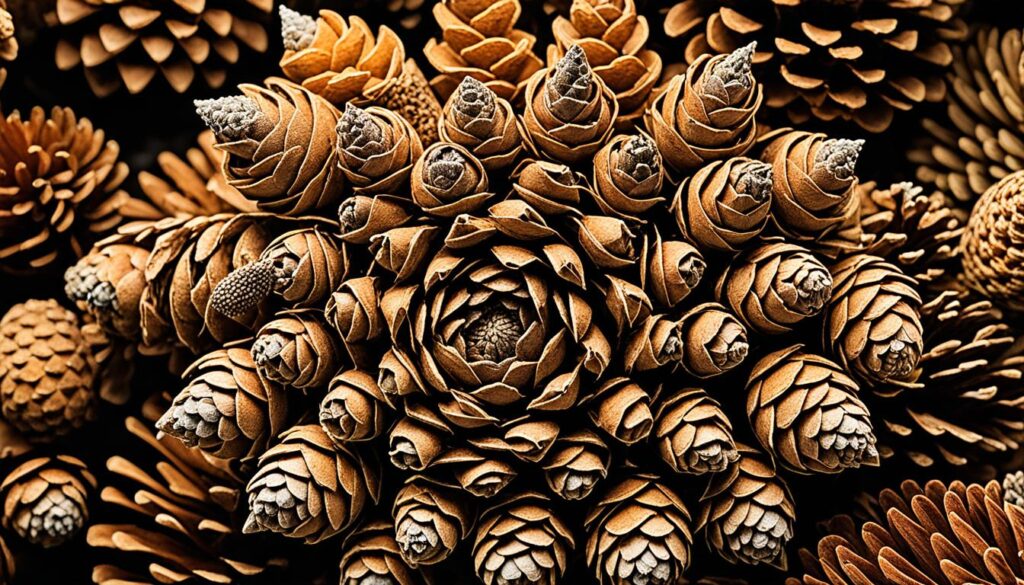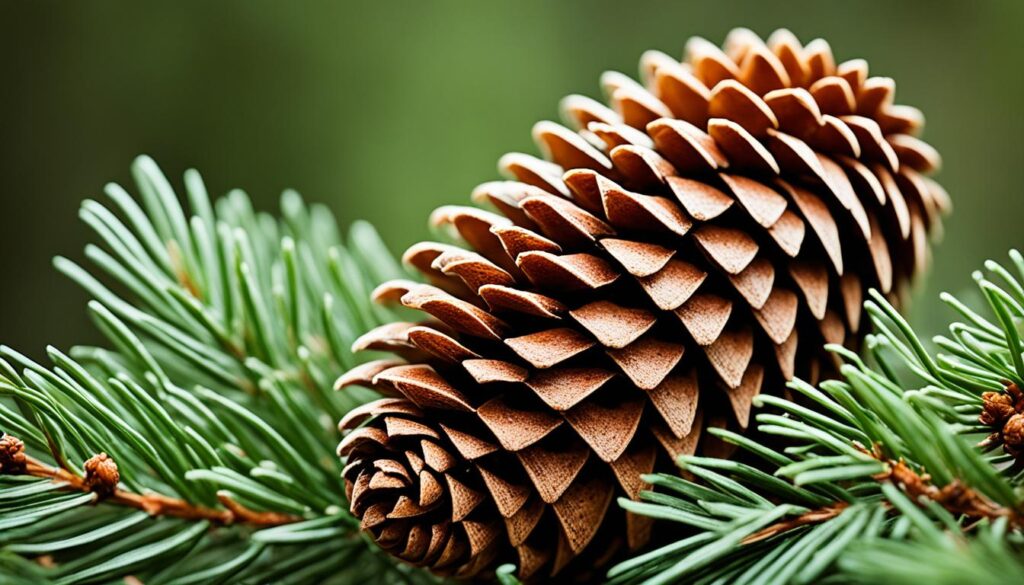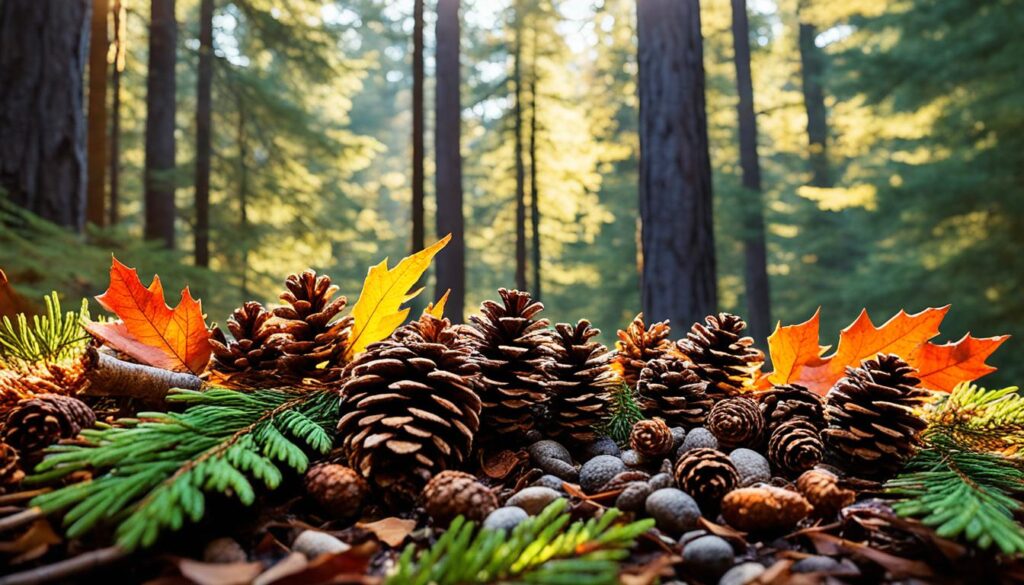Ever thought about the amazing journey of pine cones? These cone-shaped seed carriers have been around for over 200 million years. They are a key part of our forests. Pine cones, with their overlapping scales, help pine trees survive and grow back. But what makes them so important?
What are Pine Cones and Their Significance?
Pine cones are key parts of pine trees, helping them reproduce. They are made up of scales that protect and carry the seeds. These cones are crucial for the life and long lives of pine trees.
Pine Cones as Seed Carriers
Pine cones help pine trees make more trees. Each cone has many scales, each with two seeds. When the cone opens, the seeds spread out to grow new trees.
Not all pine trees have cones big enough for nuts. But some, like the pinyon pines, do. These trees live high up and have some of the best nuts. Their nuts are full of vitamins, minerals, and protein.
The Longevity of Pine Trees
Pine trees, like the Pinus longaeva or Bristlecone Pine, live a very long time. The oldest Bristlecone Pine, named Methuselah, is 4,765 years old. This shows how strong and adaptable these trees are.
The pine cone’s design, with the Golden Ratio in its growth, has always fascinated people. From ancient times to today, its beauty and math have caught our attention. This shows how important pine cones are in nature.

| Characteristic | Statistic |
|---|---|
| Varieties of pine trees that produce cones with large enough pine nuts for harvesting | Only 20 |
| Altitude range for Pinyon pines, which offer the finest pine nuts in North America | 6,000 to 9,000 feet |
| Age of the oldest known Bristlecone Pine, Methuselah | 4,765 years |
Exploring Pine Cones: A Sensory Experience
Step into the world of pine cones and use all your senses. These natural wonders offer a rich sensory experience. They help you connect more with the forest. From looking at their detailed scales to smelling their resinous scent, pine cones are full of interesting discoveries.
Observing Pine Cones with All Your Senses
Start by looking closely at the pine cone sensory experience. Notice the intricate patterns and textures of the scales. They show nature’s amazing design. Then, touch the surface with your fingers, feeling the mix of soft and hard layers.
Next, bring the pine cone to your nose and smell its earthy scent. This smell can remind you of the forest’s freshness. If you’re feeling brave, you can even taste a small, safe part of the pine cone. Some cones have seeds that taste nutty or resinous. But, make sure to check with an expert before eating any part of a pine cone, as not all are safe to eat.
Understanding the Forest’s Natural Pharmacy
Pine cones and other forest items have many uses and properties. They are part of a natural pharmacy. People have used them for traditional remedies and herbal medicines.
The resin from pine trees can make soothing tinctures, and the needles can be turned into a tea that warms you up. Pine cones have been used in many cultures for their healing properties. They are said to be antiseptic and anti-inflammatory. Learning about these uses can show you the practical and health benefits of the forest.

By using your senses and learning about pine cone natural uses and pine cone medicinal properties, you can appreciate the forest more. This lets you connect with nature and find the amazing gifts it offers.
Pine Cones and Their Role in the Ecosystem
Pine cones are key to the forest’s health, carrying seeds and helping pine trees grow. They come in many sizes, fitting the needs of different trees. For example, the giant Sequoia’s cones can be up to 20 inches long, while the Lodgepole Pine’s cones are smaller, perfect for the mountains.
Pine Cones as a Vital Part of the Forest Ecosystem
Pine cones are more than just pretty. They feed many animals like squirrels and birds. When the seeds spread out, they grow into new trees, keeping the forest alive. The cones have male and female parts, starting the tree’s life cycle with pollination and ending with seed dispersal.
The Importance of Dead Wood and Fallen Pine Cones
After dropping their seeds, pine cones don’t stop helping the forest. They break down into nutrient-rich soil, helping plants grow. Dead wood, including pine cones, keeps nutrients in the soil, stops erosion, and homes for many species.

Pine cones help the planet by growing new trees and supporting forest life. They also inspire smart materials and energy-saving ideas with their humidity-sensitive design. Nature’s engineering is truly amazing.
Crafting with Pine Cones
Pine cones are more than just pretty decorations; they’re great for making crafts. One classic craft is making a pine branch whisk. This is a kitchen tool that looks great and works well. By using the resin from pine and fir branches, you can make a whisk that’s both strong and rustic.
Pine Branch Whisk: A Traditional Craft
To start, pick a pine or fir branch. Boil it to get rid of the resin, then remove the bark and needles. Shape the branch into a whisk, and you’ll have a unique kitchen tool. This traditional pine cone craft brings the outdoors into your kitchen, adding an earthy feel to your cooking.
Many people enjoy making crafts with pine cones. Over two-thirds of crafters clean the cones before using them. They often bake them or freeze them to get rid of bugs and dirt.
| Cleaning Method | Percentage of Crafters |
|---|---|
| Baking at 200°F for 25-30 minutes | 60% |
| Soaking in vinegar and water for 30-40 minutes | 40% |
| Freezing | 15% |
| Bleaching (not recommended) | 10% |
After cleaning, the pine cones are ready for many crafts. You can make beautiful things like terrariums and wreaths, or fun decorations like pine cone owls and topiary. The natural beauty of pine cones is perfect for all sorts of projects.
Whether you’re an expert or a beginner, pine cones can add a rustic touch to your crafts. They connect you to nature and let your creativity grow. So, get creative with these forest treasures.
Pine Cone Decorations and Ornaments
Pine cones are nature’s gifts that can be turned into charming decorations for your home. They can be used to make simple Christmas trees or more complex designs. By painting, gluing, or decorating them, you can make unique ornaments that celebrate nature’s beauty.
Creating festive wreaths with pine cones is a popular idea. Use a mix of white and natural pine cones for a rustic look. Or, paint them green to look like fresh evergreens for a bold style.
Pine cones are great for decorating your Christmas tree too. Spray them with metallic paint for a shiny look or add faux snow for a winter feel. You can also pair them with spray-painted walnuts for unique ornaments.
Pine cones can be used in many holiday displays, not just on the tree. Mix them with evergreen, ribbons, and other natural items for beautiful centerpieces. They can even add a rustic look to your gifts by combining them with greenery and a bow.
Looking for a cozy or whimsical holiday look? Pine cone decorations and ornaments have many possibilities. Let your creativity shine with these forest treasures this season.
Pine Cone Bird Feeders: Helping Wildlife in Winter
As winter comes, birds struggle to find food. Pine cone bird feeders can be a key source of food for them. By using pine cones, you can make simple bird feeders that attract many birds to your yard.
Making Pine Cone Bird Feeders with Peanut Butter or Lard
Making pine cone bird feeders is a fun family project. You’ll need pine cones, peanut butter or lard, and bird seed. Spread peanut butter or lard on the pine cones. Then, roll them in bird seed until fully coated. Hang them up and watch the birds come.
Pine cones are great for bird feeders because they hold the seed well. Peanut butter or lard gives birds a high-fat snack that keeps them warm and full.
| Pine Cone Bird Feeder Ingredients | Proportions |
|---|---|
| Bread Crumbs | 2 cups |
| Unsalted Nuts | 1/2 cup |
| Chopped Apples | 2 – 3 |
| Raisins | 2/3 cup |
| Sugar | 1 cup |
| Cornmeal | 1/4 cup |
| Ground Beef Suet | 1/2 pound |
| Flour | 1/2 cup |
| Peanut Butter | 18 oz. jar |
| Wild Birdseed | 1 cup |
Just mix all the ingredients together and press it into the pine cones. Hang them outside for the birds to enjoy all winter.
There are more DIY bird feeders you can make, like bagel feeders or wild birdseed cookies. These can help birds survive winter and add beauty to your yard. By using natural materials, you support local wildlife and decorate your outdoor space.
Botanical Dyes from Pine Cones
Discover the hidden art in pine cones with botanical dyes. These natural wonders can turn into vibrant colors, offering a green alternative to synthetic dyes. Learn about their history and how to use these plant-based colors for unique textiles and decorations.
Pine cones have been used for dyeing for many years. They contain pigments that create browns from beige to reddish-brown. By processing these dyes, you can explore creative possibilities and connect with botanical dyeing’s ancient roots.
Extracting Pine Cone Dyes
Getting dyes from pine cones is a bit tricky. The cones need a lot of boiling to release their colors. Instructions say cones from the previous year, under snow, give the best colors. Choose cones that are dark brown/reddish and moist inside for the best results.
Boiling takes almost four hours, longer than other methods because of the cones’ hardness. This effort brings out stunning natural colors for fabrics, wood, and skin.
Exploring the Diversity of Pine Cone Dyes
Pine cones offer a variety of earthy tones, from beige to reddish-brown. A 1919 Finnish book says to use spruce cones for dyeing, focusing on hard, smooth cones with juicy insides. These dyes work well on cotton, linen, and silk, each showing unique absorption.
Cotton turns beige light brown, while wool and silk take up the dye better. Adding mordants can make the colors deeper and more vibrant.
| Fabric | Dye Color | Dye Quality |
|---|---|---|
| Cotton | Beige light brown | Good |
| Linen | Warm brown | Excellent |
| Silk | Deep reddish-brown | Outstanding |
| Wool | Rich brown | Exceptional |
Exploring pine cone dyes is exciting for artists and nature lovers alike. These natural pigments let you make unique, eco-friendly art and decorations. They celebrate the forest’s beauty and its rich resources.
Pine Cone Nature Art and Activities for Kids
Pine cones are perfect for creative nature art projects and activities for kids. They can be used as stamps for painting or to make cute pine cone creatures. These activities help kids use their imagination and appreciate nature more.
Activities like arranging pine cones into patterns help kids see the world differently. They also improve their fine motor skills. It’s a great way to connect kids with the beauty of pine cones and nature.
Kids can make pine cone animals like hedgehogs, owls, and penguins. Older kids might like making pine cone fairies, elves, or Rudolph the Red-Nosed Reindeer. For the holidays, families can make pine cone Christmas trees, snowmen, and ornaments.
Using pine cones is a fun way to spend time with your kids. It also teaches them about the role pine cones play in nature. By exploring pine cones, you can inspire a love for the outdoors in your kids.



